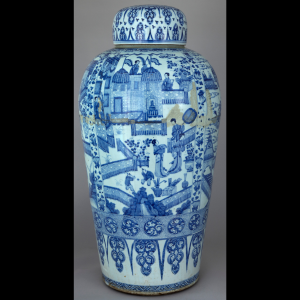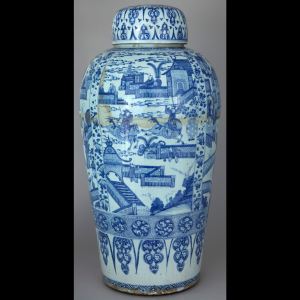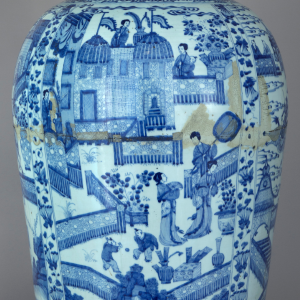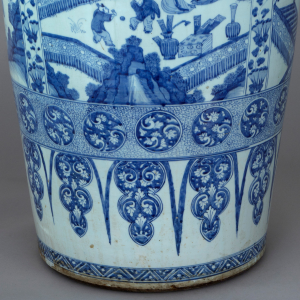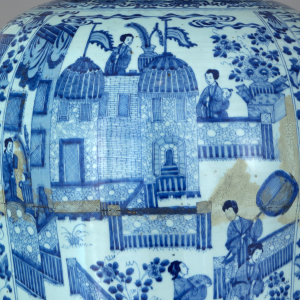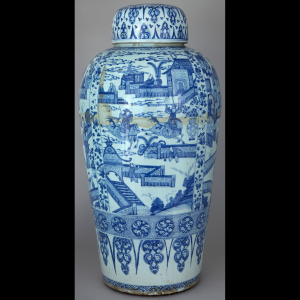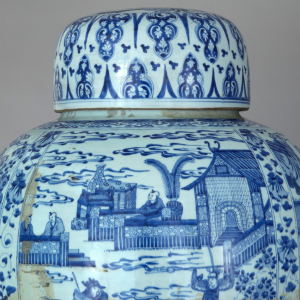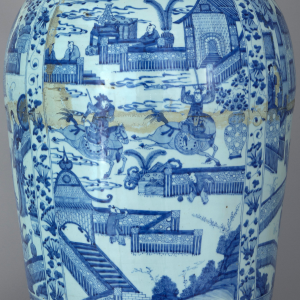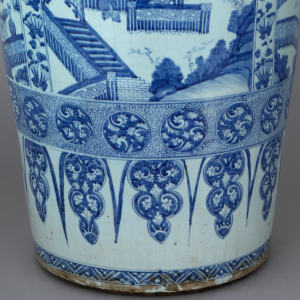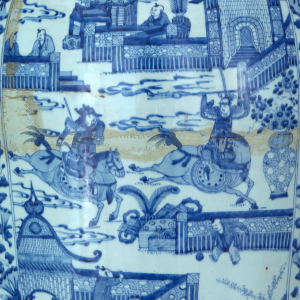Pot
Author: Unknown
Origin: Jingdezhen Kilns, China
Dating: c.1690 (Qing Dynasty, Kangxi period)
Material: Porcelain
Dimensions (cm): 102 x Ø 51,5
Inv. no.: PD0476
A pot completely covered by a lid with a flat top and without a handle. The decoration was carefully painted in cobalt blue under the glaze. It is organized into four alternating registers, as the body displays two episodes of what seems to be a narrative sequence.
One of the registers displays a representation of a bucolic scene in a palatial environment. On top of a building – made of stone with western features – and between two towers topped by domes with fringed banners, a very well-dressed female character is speaking to another woman who is carrying a child on her back. The background has dense clouds in deep blue, which may be seen in other pots and precious items from “The Hundred Antiques”. On the left side of the building, there are two (almost overlapping) painted panels showing an interior scene: on the right-hand side, a female character seems to be looking at the garden where three ladies are walking waving fans and, close to them, two children play with a ball, among fences, which are decorated in a “cracked ice” pattern, surrounded by flowering pots and pieces of furniture.
In the other register, two riders are galloping between dense blue clouds. Their swords are in hand, displaying them as warriors. Several male characters are watching these riders. They are semi-hidden within fences and garden furniture which is similar to the one in the scene described above.
Bellow, near a bridge, one may see what seems to be the access to the garden. Indifferent to the presence of the warriors, the same two children above mentioned, play with a ball between fences, surrounded by precious pots and pieces of furniture.
These episodes are separated vertically by a band of stems and peony buds, symbolically connected to the theme of love and female beauty. Horizontally, a separation between two blue lines is composed of overlapping peony corollas.
The lid has a wall filled with two courses of lobe-shaped leaves and triangles that flow without intersecting each other. Between them, there is a sequence of four small flowers.
At the top of the lid, there is a blue circle medallion where detailed objects from “The Hundred Antiques” and from the “Eight Precious Objects” may be seen. Among them, there is a pot with a peacock feather, a ruyi scepter and a rhombus. These are the symbols in the Buddhist culture that represent prosperity, victory and success.
Kangxi Period
The Kangxi Emperor was one of the most important in Chinese history. His 61-year reign (1662-1722) was the longest in Chinese history and consolidated the power of the new Qing dynasty.
In terms of porcelain production, the Kangxi period was both innovative and a continuum of various techniques used previously. A large investment was made in the Jingdezhen manufacturing centre, reaching 3000 kilns.
The painting techniques, which developed during the Ming dynasty, reached a high level of technical refinement during the Kangxi period. In addition to the production of “blue and white” porcelain, the Famille-Verte (Green Family) was created – a palette composed of green, iron red, yellow, and purple, with blue enamel being added later (c. 1700).
This period became an era of great splendour that continued through the following reigns.


